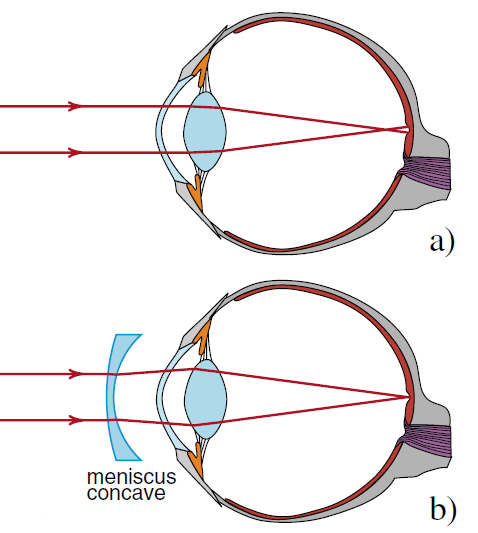
Eye Glasses and a Home Lab Experiment
 المؤلف:
E. R. Huggins
المؤلف:
E. R. Huggins
 المصدر:
Physics 2000
المصدر:
Physics 2000
 الجزء والصفحة:
1022
الجزء والصفحة:
1022
 8-1-2021
8-1-2021
 2278
2278
Eye Glasses and a Home Lab Experiment
When you get a prescription for eyeglasses, the optometrist writes down number like -1.5, -1.8 to represent the power of the lenses you need. These cryptic number are the power of the lenses measured in diopters. What a diopter is, is simply the reciprocal of the focal length 1/f, where f is measured in meters. A lens with a power of 1 diopter is a converging lens with a focal length of 1 meter. Those of us who have lenses closer to –4 in power have lenses with a focal length of –25 cm, the minus sign indicating a diverging lens to correct for nearsightedness as shown back in Figure (1).

Figure 1: Nearsightedness can be corrected by a convex lens..
If you are nearsighted and want to measure the power of your own eyeglass lenses, you have the problem that it is harder to measure the focal length of a diverging lens than a converging lens. You can quickly measure the focal length of a converging lens like a simple magnifying glass by focusing sunlight on a piece of paper and measuring the distance from the lens to where the paper is starting to smoke. But you do not get a real image for a diverging lens, and cannot use this simple technique for measuring the focal length and power of diverging lenses used by the nearsighted.
As part of a project, some students used the following method to measure the focal length and then determine the power in diopters, of their and their friend’s eyeglasses. They started by measuring the focal length f0 of a simple magnifying glass by focusing the sun. Then they placed the magnifying glass and the eyeglass lens together, measured the focal length of the combination, and used the formula
 ........(1)
........(1)
(Note that if you measure distances in meters, then 1/f1 is the power of lens 1 in diopters and 1/f2 that of lens 2. Equation 30 tells you that the power of the combination 1/f is the sum of the powers of the two lenses.
 الاكثر قراءة في مواضيع عامة في علم البصريات
الاكثر قراءة في مواضيع عامة في علم البصريات
 اخر الاخبار
اخر الاخبار
اخبار العتبة العباسية المقدسة


